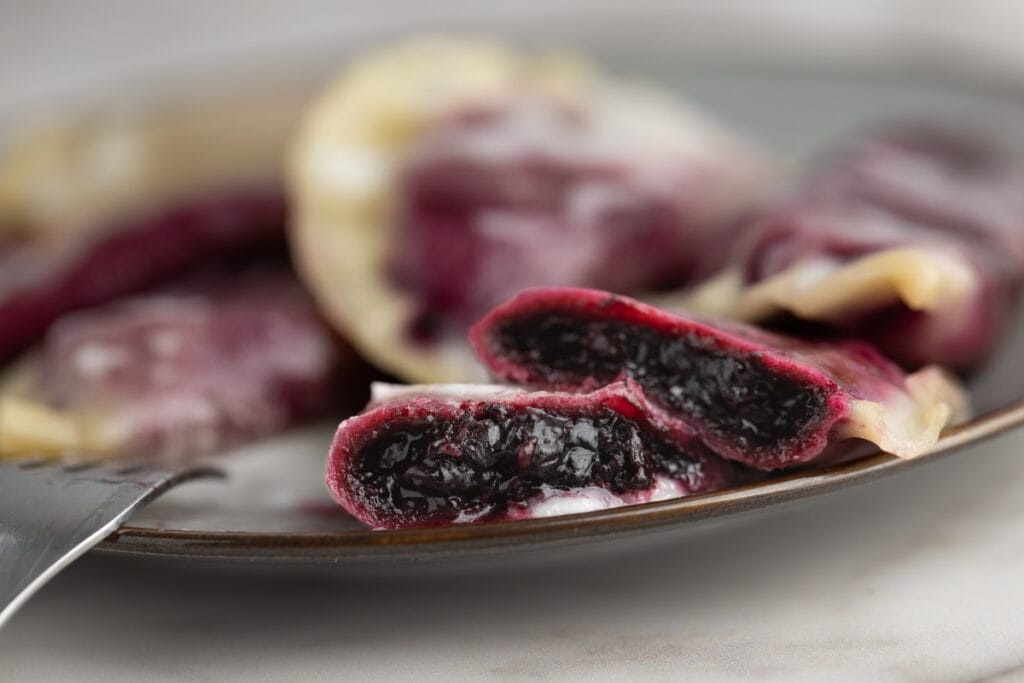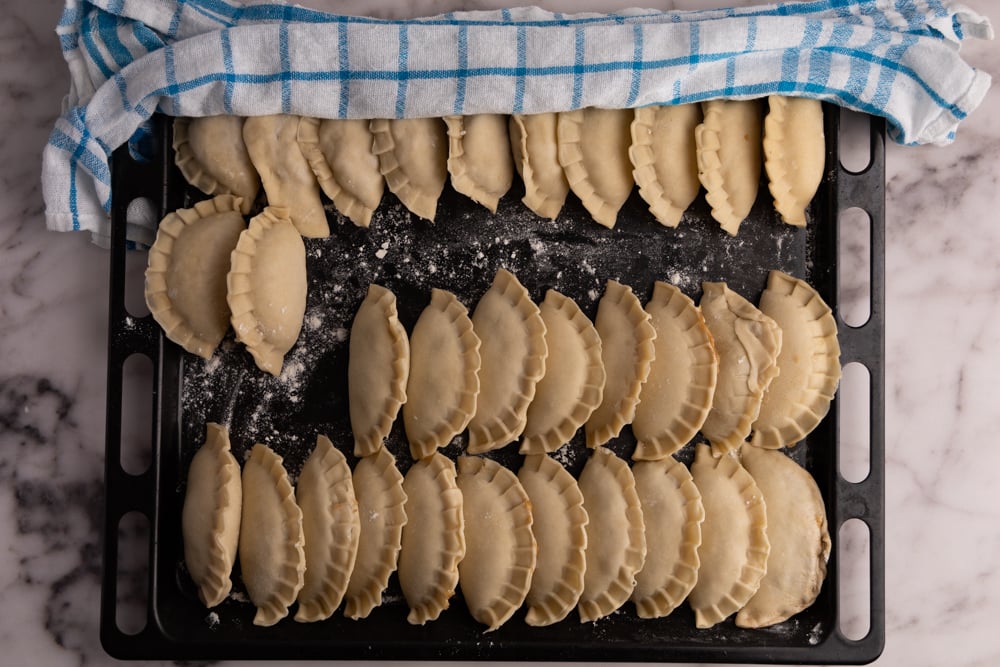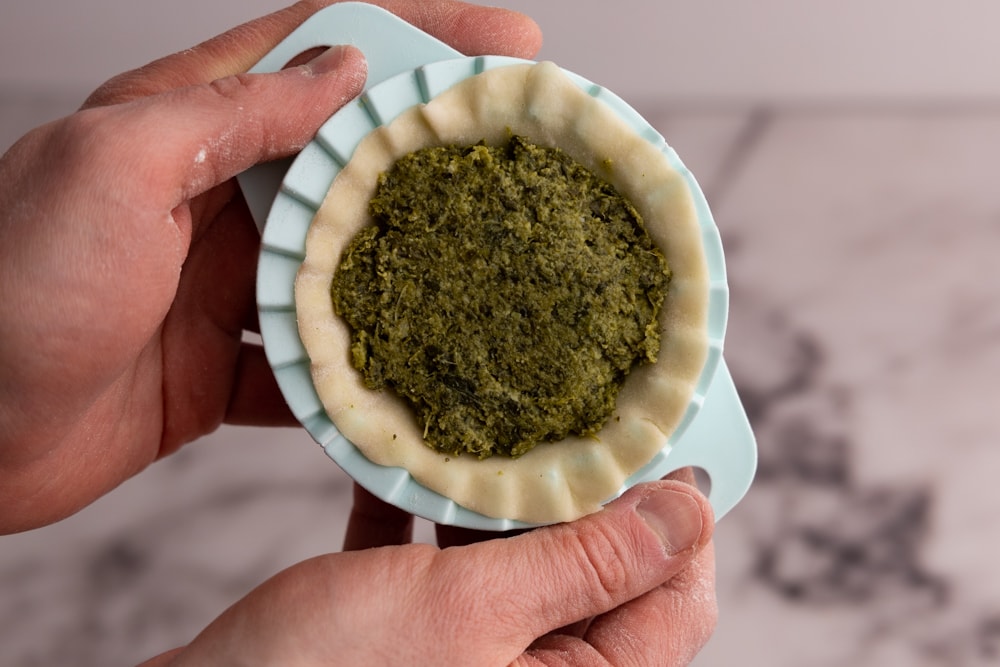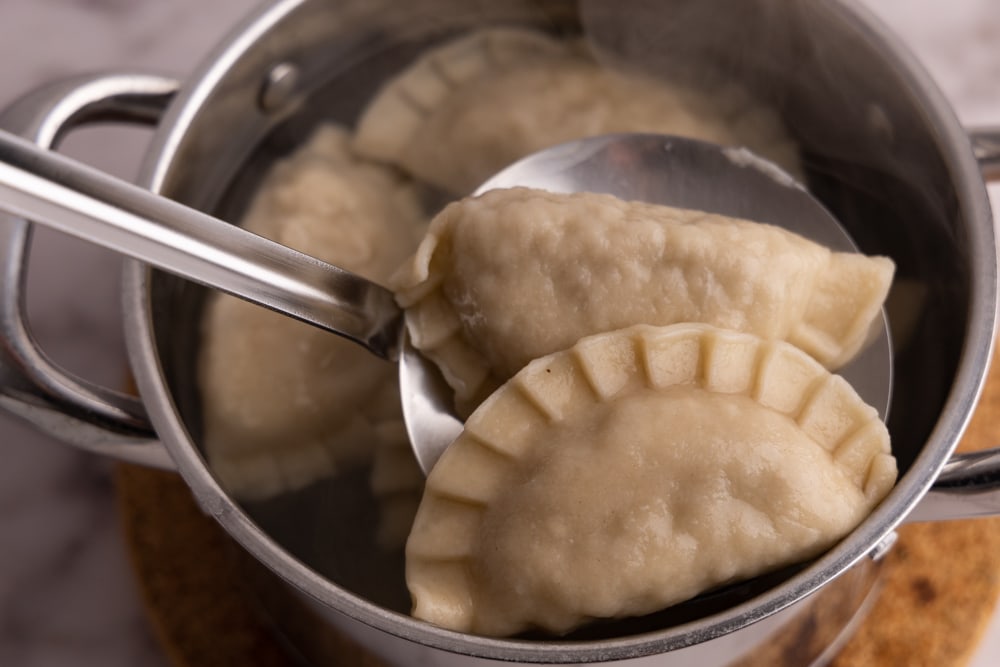Homemade Pierogi: The Ultimate Guide to Polish Dumplings
This post may contain affiliate links. Read our privacy policy.
Ever tried to whip up a batch of Polish pierogi at home, and it just didn’t turn out right? No worries, we’ve all been there.
Enter our guide to making homemade pierogi. This is your new best friend for all things pierogi! We’ll help you step-by-step to get your dough just right, your fillings flavorful, and your cooking spot on.
We’ve got loads of tips, tricks, and good ol’ grandma-style advice to share. It’s everything I learned while going from a first-time pierogi maker to someone comfortable with the process and trying out different fillings and dough recipes.

If you read the whole guide, you’ll know where to start, what are your options for dough and filling, and how to start adjusting the recipes to your needs.
Ready to dive in and make some tasty dumplings? Let’s roll up our sleeves and get to it.
Pierogi 101
Pierogi, those delightful filled dumplings, are the beloved staple of Eastern European cuisine. Made by swaddling sweet or savory fillings in a blanket of unleavened dough and gently simmering in boiling water. Pierogi have earned a place of honor on dining tables, particularly in Poland and Ukraine (where they answer to the name ‘vareniki’).
Their filling could range from a humble potato or tangy sauerkraut, to hearty ground meat, rich cheese, or even luscious fruit.
The birth story of pierogi, however, is quite ambiguous.
The earliest written mention of pierogi in Poland can be traced back to the 17th century, but there’s a strong belief that these delectable dumplings have been around for quite a while longer. Legend has it that Saint Hyacinth introduced pierogi to Poland in the 13th century, a tale commemorated by the grand pierogi festival in Cracow, Poland, held around the Day of St. Hyacinth.

But let’s step back and look at the bigger picture. Pierogi are just one branch on the vast family tree of stuffed dumplings, celebrated in cultures worldwide.
Think about pelmeni, Russian meat-filled dumplings, or picture the Latin American empanadas, pastries brimming with meat, cheese, or fruit. Or, take a culinary trip to China, where potstickers (also known as jiaozi or gyōza) hold sway. These dumplings, typically pan-fried, are served with an irresistible dipping sauce.
Each has its unique twists, be it in preparation or ingredients, yet they all beat to the same rhythm: a doughy exterior harboring a burst of flavor. And that’s what pierogi are all about.
With that in mind, let’s make some pierogi.
Step 1: Make Pierogi Dough
Now, let’s jump into the world of pierogi dough where there are tons of recipes out there just waiting to be tried. But when you peek under the hood, they all share a similar DNA.
The MVPs of any pierogi dough are flour, water, and typically some sort of fat. This could be oil, eggs, egg yolks, butter, or a delightful mix of these. Each lends a subtle tweak to the flavor profile, but what we’re after is a dough that’s pliable and a joy to roll out.
In my kitchen, I typically use my tried-and-true pierogi dough recipe. It’s a straightforward lineup of all-purpose flour, water, vegetable oil, and a pinch of salt—ingredients probably lounging in your pantry right now.

If you’re feeling adventurous, there are certainly more elaborate pierogi dough recipes out there, like this one. It skips the water and instead calls for an egg, sour cream, and butter to step in as the wet brigade. Sure, it’s a bit more calorie-packed, but it should get the job done beautifully.
For those with a palate for robust flavors, whole wheat flour pierogi dough could be your next culinary love. It brings a distinct flavor that all-purpose flour can’t match, but bear in mind that it’s a bit of a diva to work with and tears more readily.
If you’re new to the pierogi game, starting with a simple all-purpose flour dough is your safest bet. Once you’ve got a few pierogi parties under your belt, feel free to venture into uncharted territory.
Alright, you’ve chosen your pierogi dough recipe, and the dough is ready. What’s next? Patience, my friend, as it’s time for your dough to take a breather.
Letting your wrapped pierogi dough rest allows the gluten to relax, resulting in a dough that’s more pliable and easier to roll out, making the pocket formation a breeze. So kick back, relax, and let the dough do its thing. Or start prepping the filling.
Step 2: Choose Your Filling
The versatility of pierogi lies in its diverse filling options. When choosing your stuffing, aim for a sturdy yet malleable mix so that it’s easy to fill the pockets without making a huge mess all over the place.
Classic options include the traditional potato and cheese—a smooth mixture of mashed potatoes and cheese – meat filling, which can be as simple as seasoned ground meat, and the tangy sauerkraut and mushrooms, often a Christmas favorite but enjoyable year-round.

Innovative modern fillings have also emerged, like the flavorful spinach and feta cheese filling, which can be made vegan if you skip the cheese and add some garlic instead. Lentils make for a delicious vegan filling as well. The potato filling allows for creativity with additions like onions or sour cream. If in season, try an asparagus and mascarpone cheese filling for a unique take on pierogi.
Related: Looking for vegan fillings? Here’s a whole article on vegan pierogi.
And let’s not forget the dessert! Sweet pierogi fillings are a delightful surprise. Opt for the easily accessible apple pierogi, super simple plum pierogi, the versatile strawberry filling that can be made two ways (the same being true for blueberry filling), or a traditional farmer’s cheese pierogi that’s a Polish favorite. Or, if you’re feeling creative, open up my sweet cheese pierogi recipe that you can easily customize exactly to your liking.
Ultimately, the choice of filling reflects the beauty of pierogi: there’s something for every taste, from traditional to modern and sweet.
Want to know more? Here’s our epic guide to pierogi fillings.

Step 3: Assemble Pierogi
Now comes the fun part: assembling your pierogi.
Kick off by rolling out the dough. Take the rested dough, snip off a piece, and roll it out on a generously floured surface until it’s slim and trim. Make sure the rolled-out dough is thick enough to withstand a bit of stretching.
(If you’re juggling a rather juicy filling, like for fruit pierogi, you may want to err on the side of a slightly thicker dough.)
Next up, it’s time to carve out your circles. You can unleash your creativity here: a round cutter, a glass or mug, or even the rim of a mason jar can do the trick. Once you’ve snipped out your circles, gather the leftover dough into a ball, ready for the next round of pierogi crafting.

Now comes the transformation into pierogi pockets. Spoon a dollop of filling onto your dough circle, fold it over to form a half-moon, and crimp the edges to seal the deal. Start pressing from the center and work your way out, ensuring no pesky air pockets are hiding inside.
Usually, your dough circles can chill on the surface while you’re loading them with filling and sealing them shut. But if you’re dealing with a slightly unruly filling that likes to spill (I’m looking at you, fruit pierogi), it helps to cradle the dough circle in your hand like a little bowl before filling. This extra step ensures your filling stays right where it belongs.

Finally, sweep the finished pierogi onto a flour-dusted surface and keep them cozy under a kitchen towel until they dive into the boiling pot. This keeps them from drying out. If your pierogi are socializing a bit too closely, dust the touching areas with flour to prevent them from sticking.

Tips for Assembling
- Consider a pierogi maker. If pierogi making is becoming a regular gig, a pierogi maker might be a wise investment as it can be a real timesaver. But don’t jump the gun. Go hands-on for your first few sessions to get a feel for the process and see if pierogi crafting is a fleeting passion or a long-term love affair. If you’re only whipping up pierogi a few times a year, another single-use gadget isn’t worth the cupboard space.

- Keep water nearby. Keep some water within arm’s reach. If your dough becomes a tad too floury and resists sealing, a moist finger run around the dough’s edge will do wonders. I used to rely on that water for the first few pierogi-making sessions, but as I got some experience under my belt, I didn’t need it nearly as often.
Step 4: Cook
We’re on the home stretch here.
To cook your carefully assembled pierogi, rally a large pot of water, dose it generously with salt (a good rule of thumb is one teaspoon salt per quart of water), and set it to boil. Once it’s bubbling, introduce a few pierogi to the water, mindful not to throw a crowded party, and stir them to stop them from sticking to each other and the bottom. Simmer the pierogi until they bob to the surface, then let them enjoy a further 1 to 4-minute soak post-resurfacing.
Once they’ve had their swim, they’re ready to go. Use a slotted spoon to rescue the cooked pierogi from their steamy bath, and they’re ready to serve or store.

Step 5: Add Sauce or Topping (Optional)
Sure, straight-off-the-pan pierogi are a treat in themselves, and that’s how we often relish them in Poland. However, adding that extra zing with a sauce or topping can take your pierogi experience from delicious to extraordinary.
There are the ever-reliable options like sour cream and melted butter that effortlessly blend with almost all pierogi fillings, whether sweet or savory. But why limit yourself when there’s a world of possibilities waiting to be explored?
Consider these creative add-ons:
- Sauteed onions. These are a stellar match for savory pierogi, and whipping them up is a breeze. Here’s a write-up on how to make pierogi with sauteed onions.
- Garlic sauce. A quick and easy preparation that lends a delightful kick to your savory pierogi.
- Ice cream. Looking to jazz up your sweet pierogi? You can’t go wrong with a dollop of vanilla ice cream.
- Fresh fruit. The perfect partner for dessert pierogi – it’s uncomplicated yet sophisticated and oh-so delectable.
Want to learn more? Here’s our guide that covers all things related to pierogi sauces and toppings.
Tips for Making Pierogi
Here are a few tips you should find helpful:
- Find a pierogi dough recipe that you trust. Many online recipes cover both the dough and the filling in the same recipe. Instead of tackling a new dough each time, it’s better to scout a go-to recipe you resonate with and stick to it, at least initially. This strategy clears the dough hurdle, freeing up your creative energy to experiment with the filling. My best pierogi dough recipe is my choice, as it works well with various fillings, and the necessary ingredients are pantry staples.
- Limit extra fat in the filling. When making pierogi, oftentimes you’ll use oil or butter, be it for cooking the meat or sauteing onions. When doing so, remember to use as little fat as possible without burning the food. If you use lots of oil and don’t strain it, the resulting pierogi will be greasy. And greasy pierogi make the flavor go from 9/10 to 5/10 instantly.
- Supersize your recipe. Crafting a single batch of pierogi ranges from 90 minutes to two hours (if you need something to eat and fast, check out my lazy pierogi recipe). However, if you supersize your batch, the time doesn’t scale linearly but rather increases by about 50 percent. Therefore, a single two-hour batch morphs into a double batch taking three hours. It’s a time-efficient strategy since most of the prep work and cleaning stays constant, irrespective of the batch size. Once you’ve built a rapport with pierogi-making, start producing in bulk and freeze the extra.
- Dabble with diverse fillings. One filling won’t appeal to everyone’s palate. If spinach or lentils don’t tickle your fancy, that’s perfectly fine. Start by exploring fillings that pique your curiosity. And if you’re supersizing your recipe, embrace the opportunity to experiment with a range of fillings, adding a dash of novelty to your pierogi adventure.
How to Store Pierogi
To store the pierogi, you need to let them dry, then transfer them into an airtight container and refrigerate. They’ll keep for 3 to 4 days in the fridge, or you can freeze them if you need more time.
That’s the short version. Now, let’s get into the details.
Once boiled, transfer the pierogi loosely onto large plates, and let them sit for 10 to 15 minutes to dry out. After that period, flip them so the other half can dry too.
We dry the pierogi to prevent sticking. That’s why we place them loosely and not in a big bunch.

Once dry, place the pierogi in airtight containers or freezer bags, and seal tightly. Make sure they’re not packed, and only lightly touch one another. Again, that’s to prevent sticking.
If you want to stack them, separate the layers using plastic or aluminum wrap.
Stored this way, the pierogi stay safe in the fridge for about 4 days.

If you make a big bunch, you can easily freeze any extra. That’s why I recommend doubling or tripling the recipes.
Frequently Asked Questions
How Long to Boil Pierogi?
Once you plunge the pierogi into boiling water, bring the water back to a simmer, wait until the dumplings resurface, then let them simmer for 1 to 4 minutes. 1 to 2 minutes is easily enough for pierogi with fruit-based fillings and other fillings that are fairly soft. For firmer fillings, like meat or farmer’s cheese pierogi, go for 3 to 4 minutes.
